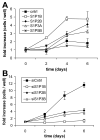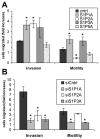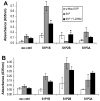Roles of sphingosine-1-phosphate (S1P) receptors in malignant behavior of glioma cells. Differential effects of S1P2 on cell migration and invasiveness
- PMID: 17376432
- PMCID: PMC2100382
- DOI: 10.1016/j.yexcr.2007.02.009
Roles of sphingosine-1-phosphate (S1P) receptors in malignant behavior of glioma cells. Differential effects of S1P2 on cell migration and invasiveness
Abstract
Sphingosine-1-phosphate (S1P) is a bioactive lipid that signals through a family of five G-protein-coupled receptors, termed S1P(1-5). S1P stimulates growth and invasiveness of glioma cells, and high expression levels of the enzyme that forms S1P, sphingosine kinase-1, correlate with short survival of glioma patients. In this study we examined the mechanism of S1P stimulation of glioma cell proliferation and invasion by either overexpressing or knocking down, by RNA interference, S1P receptor expression in glioma cell lines. S1P(1), S1P(2) and S1P(3) all contribute positively to S1P-stimulated glioma cell proliferation, with S1P(1) being the major contributor. Stimulation of glioma cell proliferation by these receptors correlated with activation of ERK MAP kinase. S1P(5) blocks glioma cell proliferation, and inhibits ERK activation. S1P(1) and S1P(3) enhance glioma cell migration and invasion. S1P(2) inhibits migration through Rho activation, Rho kinase signaling and stress fiber formation, but unexpectedly, enhances glioma cell invasiveness by stimulating cell adhesion. S1P(2) also potently enhances expression of the matricellular protein CCN1/Cyr61, which has been implicated in tumor cell adhesion, and invasion as well as tumor angiogenesis. A neutralizing antibody to CCN1 blocked S1P(2)-stimulated glioma invasion. Thus, while S1P(2) decreases glioma cell motility, it may enhance invasion through induction of proteins that modulate glioma cell interaction with the extracellular matrix.
Figures










Similar articles
-
Sphingosine-1-phosphate regulates glioblastoma cell invasiveness through the urokinase plasminogen activator system and CCN1/Cyr61.Mol Cancer Res. 2009 Jan;7(1):23-32. doi: 10.1158/1541-7786.MCR-08-0061. Mol Cancer Res. 2009. PMID: 19147534 Free PMC article.
-
The G protein-coupled receptor S1P2 regulates Rho/Rho kinase pathway to inhibit tumor cell migration.Cancer Res. 2005 May 1;65(9):3788-95. doi: 10.1158/0008-5472.CAN-04-2311. Cancer Res. 2005. PMID: 15867375
-
Ligand-dependent inhibition of B16 melanoma cell migration and invasion via endogenous S1P2 G protein-coupled receptor. Requirement of inhibition of cellular RAC activity.J Biol Chem. 2003 Aug 29;278(35):32841-51. doi: 10.1074/jbc.M305024200. Epub 2003 Jun 16. J Biol Chem. 2003. PMID: 12810709
-
Sphingosine 1-phosphate (S1P) signaling in glioblastoma multiforme-A systematic review.Int J Mol Sci. 2017 Nov 17;18(11):2448. doi: 10.3390/ijms18112448. Int J Mol Sci. 2017. PMID: 29149079 Free PMC article.
-
Sphingosine 1-phosphate signalling.Development. 2014 Jan;141(1):5-9. doi: 10.1242/dev.094805. Development. 2014. PMID: 24346695 Free PMC article. Review.
Cited by
-
Sphingosine 1-Phosphate Receptors in Cerebral Ischemia.Neuromolecular Med. 2021 Mar;23(1):211-223. doi: 10.1007/s12017-020-08614-2. Epub 2020 Sep 10. Neuromolecular Med. 2021. PMID: 32914259 Review.
-
Effect of S1P5 on proliferation and migration of human esophageal cancer cells.World J Gastroenterol. 2010 Apr 21;16(15):1859-66. doi: 10.3748/wjg.v16.i15.1859. World J Gastroenterol. 2010. PMID: 20397263 Free PMC article.
-
Sphingolipid Signaling and Complement Activation in Glioblastoma: A Promising Avenue for Therapeutic Intervention.Biochem (Basel). 2024 Jun;4(2):126-143. doi: 10.3390/biochem4020007. Epub 2024 Jun 6. Biochem (Basel). 2024. PMID: 38894892 Free PMC article.
-
Role for CCN1 in lysophosphatidic acid response in PC-3 human prostate cancer cells.J Cell Commun Signal. 2024 Feb 20;18(1):e12019. doi: 10.1002/ccs3.12019. eCollection 2024 Mar. J Cell Commun Signal. 2024. PMID: 38545253 Free PMC article.
-
Regulation and functions of sphingosine kinases in the brain.Biochim Biophys Acta. 2008 Sep;1781(9):459-66. doi: 10.1016/j.bbalip.2008.04.008. Epub 2008 Apr 29. Biochim Biophys Acta. 2008. PMID: 18485923 Free PMC article. Review.
References
-
- Spiegel S, Milstien S. Sphingosine-1-phosphate: an enigmatic signalling lipid. Nat Rev Mol Cell Biol. 2003;4:397–407. - PubMed
-
- Hla T. Physiological and pathological actions of sphingosine 1-phosphate. Semin Cell Dev Biol. 2004;15:513–520. - PubMed
-
- Spiegel S, Milstien S. Exogenous and intracellularly generated sphingosine 1-phosphate can regulate cellular processes by divergent pathways. Biochem Soc Trans. 2003;31:1216–1219. - PubMed
-
- Lefranc F, Sadeghi N, Camby I, Metens T, Dewitte O, Kiss R. Present and potential future issues in glioblastoma treatment. Expert Rev Anticancer Ther. 2006;6:719–732. - PubMed
Publication types
MeSH terms
Substances
Grants and funding
LinkOut - more resources
Full Text Sources
Other Literature Sources
Medical
Miscellaneous

